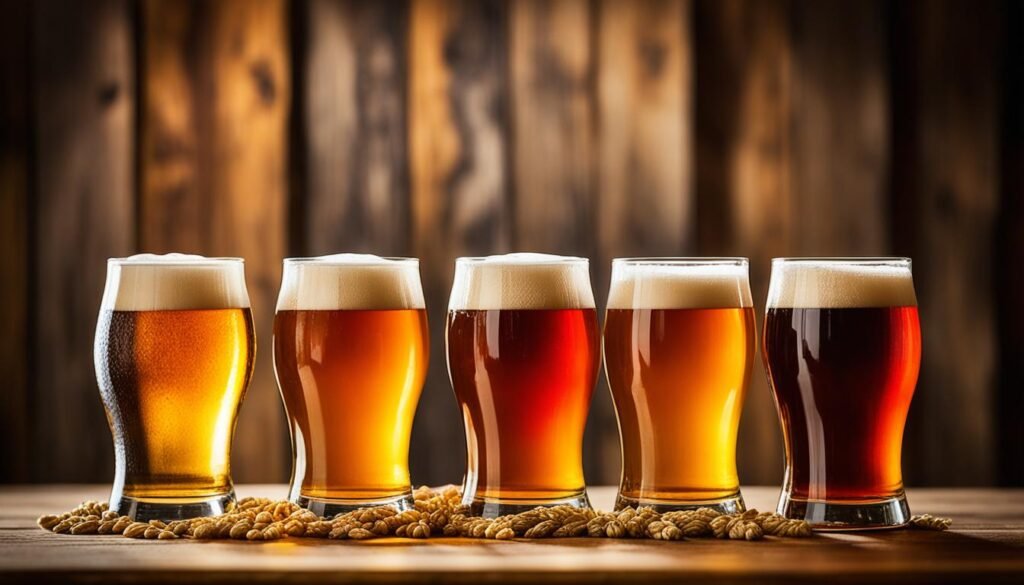Welcome to our South African beer guide. We’re diving into the world of beer, a drink loved for centuries. It’s made from cereal grains, hops, water, and yeast. South Africa offers a wide range of beers that suit our tastes.
This guide will help us understand the different beers available. We’ll learn about the brewing process and popular beer styles. Let’s improve our beer knowledge and maybe find a new favourite. For more info, check out this article on top-rated beer brands worldwide.
Key Takeaways
- South Africa has a wide range of beer varieties, offering diverse flavours and styles.
- Beer is mainly classified into ales and lagers, each with unique traits.
- Lagers include Pilsners, Munich Helles, and Vienna Lager.
- Ales have richer flavours, like Pale Ales, IPAs, and Stouts.
- Knowing the different beers helps us pick one that we’ll enjoy.
- South Africa’s beer market is big, making up 34% of Africa’s beer sales.
Understanding the Basics of Beer
Learning about beer’s basics helps us appreciate this classic drink more. Beer is made from fermented grains like barley, mixed with water, hops, and yeast. This mix goes through a detailed brewing process. Sugars from the grains are extracted and yeast ferments them, creating the flavours we love in beer.
What is Beer?
Beer is a drink with a long history, offering a wide range of flavours and styles. It’s mainly divided into ales and lagers. Ales use top-fermenting yeast at warmer temperatures, taking 2 to 5 weeks to mature. Lagers, on the other hand, ferment at cooler temperatures, needing 1 to 2 months before they’re ready.
Each type has its own unique taste, as outlined in a beer styles guide. This guide helps us understand the different popular beers out there.
Brewing Ingredients and Process
The brewing ingredients are crucial for the quality of beer. Hops add a bitter taste and aroma, malt brings sweetness and flavour, and yeast turns sugars into alcohol. The choice of these ingredients affects the beer’s taste, colour, bitterness, and alcohol level.
For instance, Pale Ales have an ABV of 4-7%, while India Pale Ales (IPA) are stronger and more hoppy. In Africa, beer-making traditions and ingredients create unique beers. These traditions reflect the region’s rich culture. We learn more about these styles in our beer styles guide.
Types of Beer
When we talk about beer, we find two main types: ales and lagers. The main difference is the yeast used during making, which changes the taste and smell of the beer.
Classification: Ales vs. Lagers
Ales are made at warmer temperatures, between 60°F to 75°F. They use yeast called Saccharomyces cerevisiae. This makes them taste complex and fruity.
Lagers, on the other hand, are made at cooler temperatures, from 35°F to 55°F. They use yeast called Saccharomyces pastorianus. This gives them a crisp and refreshing taste.
Understanding Beer Styles
Within ales and lagers, there are many popular styles. Ales include pale ales, IPAs, stouts, porters, and brown ales. Lagers have styles like Pilsners, Bocks, and Munich-style lagers.
There are also specialty beers like fruit beers and sour ales for those who like to try new things.
Discover more about different typesof.
Popular Beer Varieties in South Africa
In South Africa, beer trends are global but also keep local traditions. Carling Black Label is a top seller, showing its cultural importance and popularity. Devil’s Peak Black IPA and Castle Lager are also favorites for their unique tastes.
These beers show how tastes are changing, with people looking for quality and variety. Knowing about popular beer styles helps us enjoy beer more.
Lagers: Crisp and Refreshing Beers
Lagers are a top choice for many, loved for their crisp and refreshing taste. In South Africa, we have a lively lager scene with many styles. Each style brings its own unique flavours and traits to the table.
Popular Lager Styles in South Africa
Our local beer culture is filled with various popular lager styles. Let’s explore some of the main ones:
- Pilsners: These beers are known for their dry, aromatic taste. They often have a flinty flavour from hops like Saaz.
- Helles: This traditional German pale lager is a mix of sweet malt and floral hops. It’s a favourite for many.
- Vienna Lagers: With their amber colour, these lagers have a rich malt taste. They’re sweet and biscuity.
- Dunkels: Coming from Germany, these dark lagers have smooth malt flavours and low bitterness. They’re great for those who like depth in their beer.
Characteristics of Lager Beers
Lagers are known for their light body, making them easy to drink. They use bottom-fermenting yeast, which ferments at cooler temperatures. This gives them a clean and crisp finish.
They also have a lower alcohol content than ales. This makes them accessible to a wide range of drinkers.
There’s a variety of flavours in lagers. Mexican lagers are simple and smooth, while Pilsners have a spicy taste. Dark lagers offer aromas of chocolate and coffee but are still light-bodied.
This variety lets brewers get creative with ingredients. It leads to new and refreshing flavours across South Africa.
Ales: Full-bodied and Flavorful Brews
Ales are known for their rich and varied flavours. They are made with top-fermenting yeast at warmer temperatures. This process creates complex profiles that suit many tastes. The various styles of ales offer unique experiences for beer lovers, making them a favourite for those who enjoy depth in their drinks.
Different Styles of Ales
Exploring the different styles of ales reveals a wide range of choices. These include:
- Pale Ales
- India Pale Ales (IPAs)
- Porters
- Stouts
- Milds
- Abbey Ales
- Nut Browns
Each style has its own unique character and flavours, adding to our appreciation for brewing.
Understanding the Rich Flavours of Ales
Ales offer intriguing and varied flavours. We often find fruity, acidic, and sometimes bitter tastes that make a lasting impression. For example:
| Style | ABV Range | IBU Range |
|---|---|---|
| IPA | 5.0-14.0% | 30-100 |
| Stout | 3.8-8.9% | 20-60 |
| Porter | 4.5-12.0% | 20-50 |
| Pale Ale | 4.0-6.0% | 30-50 |
These statistics show how diverse ale flavours can be. Whether you like the hoppy taste of an IPA or the rich notes in a stout, ales offer a world of flavours to explore.

Craft Beer Revolution in South Africa
The craft beer revolution in South Africa is changing our beer culture in exciting ways. It started in the 1980s and has made a big impact on the history of craft beer. Now, with over 200 craft breweries, we have a wide range of tasty beers for those who like to try new things.
History of Craft Beer in South Africa
Craft beer started with microbreweries. It’s great to see a move towards better quality and traditional brewing. The first big brewery, Castle Brewery, opened in Johannesburg in 1895. By 2008, only 20 craft breweries existed, but now there are over 200.
This growth has led to breweries trying new styles and connecting with us through beer festivals and tours.
Popular Craft Beer Styles
We have a wide variety of popular craft beer styles like IPAs, stouts, porters, and pilsners. These beers often include local ingredients for unique tastes, such as fruit, chocolate, or coffee. This creativity makes for a rich, artisanal experience.
Brands like Devil’s Peak Brewing Company and Darling Brew are leading this change. They are known for their large barrel-aging beer program and being Africa’s first carbon-neutral brewery, respectively.
Leading Craft Breweries to Explore
Jack Black’s Brewing Co. and Devil’s Peak are at the forefront of the craft beer scene. They offer unique beers made with quality ingredients and traditional methods. Big companies investing in craft beer or starting their own brands adds to the excitement.
This revolution not only brings us better beer but also creates a community among beer lovers.
Conclusion
We’ve explored the world of beer and now see the amazing variety in South Africa. From crisp lagers to rich ales and creative craft beers, there’s a beer for everyone. Each type tells a story of a brewing tradition that spans centuries.
Our journey shows the skill in making each beer. New styles and old methods mix in the South African beer scene. This mix honours both new ideas and tradition. Now, we can enjoy our favourite beers, knowing their deep history.
Let’s keep enjoying the wide range of beers and their cultural importance. Whether it’s a favourite lager or a new craft ale, we can choose with confidence. This knowledge lets us explore South Africa’s beer diversity with joy and insight.
FAQ
What are the main types of beer?
There are two main types of beer: ales and lagers. Ales use top-fermenting yeast at warmer temperatures, giving them fruity and complex tastes. Lagers, with bottom-fermenting yeast at cooler temperatures, taste crisp and refreshing. Styles within these categories include IPAs, stouts, and pale ales.
What are the flavour differences between ales and lagers?
Ales have full-bodied and complex flavours, like fruity, hoppy, and malt-forward tastes. Lagers are crisp, clean, and refreshing, with floral or slightly sweet notes. Each beer type has its own unique characteristics that we enjoy.
What are some popular beer styles in South Africa?
Popular beer styles in South Africa include Pilsner, Munich Helles, and Vienna Lager for lagers. For ales, we have pale ales, IPAs, and stouts. The craft beer movement has also brought exciting IPAs and seasonal brews, enriching our beer culture.
How do I choose the right beer for my taste preferences?
Think about what you like in a beer, such as flavour, bitterness, or sweetness. If you prefer crisp and clean beers, lagers might be for you. For rich and complex tastes, try different ale styles. Trying various beers helps us find what we love.
What role do local breweries play in South Africa’s beer scene?
Local breweries are key to South Africa’s beer scene, offering craft beers that showcase regional tastes. With over 200 microbreweries, they bring unique beer styles and innovation. Visiting these breweries for tastings and tours deepens our love for craft beer.
What are the characteristics of craft beer?
Craft beer values quality, traditional brewing, and unique flavours. Craft breweries experiment with ingredients and methods, offering a wide range of styles. Their focus on craftsmanship makes craft beer a thrilling discovery for those looking for something new.
